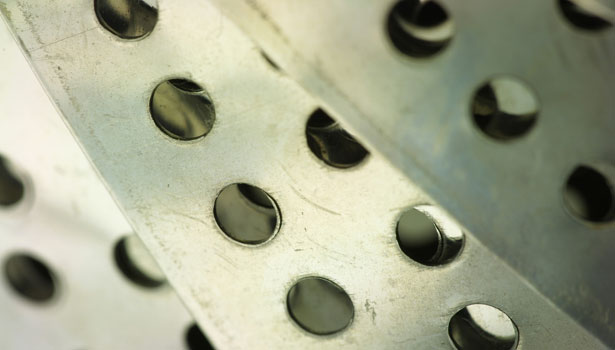Courtesy of the Industrial Perforators Association
Imagine a manufacturing process that was nearly 100 percent green. Sound too good to be true? An often overlooked but sustainable way to produce aesthetically pleasing metal pieces for different applications is, in fact, a very green practice. Perforated metals are commonly used in a variety of architectural applications, but exceedingly are seeing growth in areas outside the industry. Examples include applications for sound suppression, microwave and EMI/RFI radiation containment, filtration and purification of air, water and gases, as well as decorative uses.
The holes in perforated metal provide solutions to a number of design problems. Typically, round holes, square holes, rectangles, triangles, slots and decorative patterns are commonly punched. Hole sizes range from a few thousandths of an inch in diameter to more than three inches, while the materials that can be perforated can be as thin as foil or as thick as a one-inch steel plate.
There’s actually no secret at all to the sustainability of this manufacturing process. As holes are punched in the material, the scrap is collected by the specialized perforator performing the work. That material can then be recycled and formed back into new sheets of metal to be perforated later. Additionally, the finished piece of metal can be completely recycled after its architectural life cycle ends.
Sustainability in building design and construction is a critical process for LEED professionals to consider, and perforated materials can help them achieve their goals. The metals used in perforating usually have a high level of recycled content themselves, sometimes 100 percent. Perforated metals’ sustainability also involves more than recycling. Makers of the two main metals used in perforation, steel and aluminum, have been at the forefront of efforts to reduce carbon footprint and greenhouse gas emissions.
Sustainable architecture isn’t a fleeting trend and industry professionals will continue to have to balance new, innovative designs with next-generation building processes. Utilizing new, more sustainable materials is one way to accomplish those requirements. Increasing environmental concerns, coupled with steadily rising material costs, ensure that architects, builders and contractors will remain focused on using resources wisely while maximizing energy efficiency.
Architects, builders and LEED professionals can all continue to work together and collaborate on best practices in the industry. The long lifespan of perforated metals is one way for them to help save money and material as everyone works toward a greener, more sustainable future.
For more information on how perforated metals can help you achieve your sustainability goals, visit the Industrial Perforators Association website at www.iperf.org.
